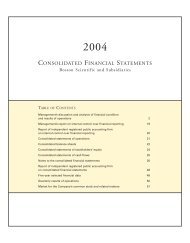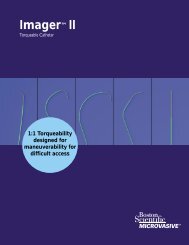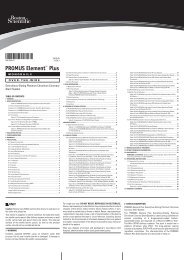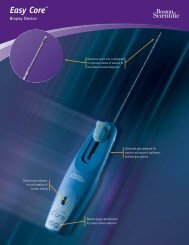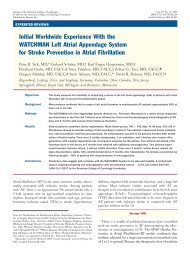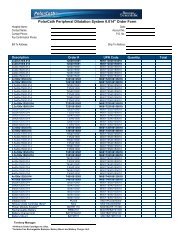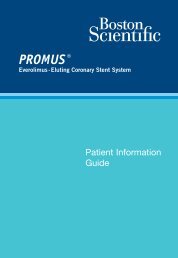Physician Reimbursement Primer for Cardiac ... - Boston Scientific
Physician Reimbursement Primer for Cardiac ... - Boston Scientific
Physician Reimbursement Primer for Cardiac ... - Boston Scientific
Create successful ePaper yourself
Turn your PDF publications into a flip-book with our unique Google optimized e-Paper software.
Chapter 2<br />
procedure, the hemodynamic stability of the patient, patient co-morbidities, and the<br />
likelihood and consequences of complications arising from the procedure.<br />
If physicians are unsure about the need, they may consider placing the patient in<br />
outpatient observation, as outpatient observation can be progressed to inpatient if the<br />
patient’s condition warrants additional care and such need is clearly and accurately<br />
documented. *<br />
ICD-9-CM Procedure Codes<br />
Hospitals report inpatient services and treatments using ICD-9-CM procedure codes, as<br />
opposed to the CPT and HCPCS procedure codes used in the outpatient setting. The<br />
ICD-9-CM codes <strong>for</strong> various inpatient procedures are identified in Chapter 5, Coding<br />
Overview.<br />
MS-DRG Basics<br />
Hospital inpatient care is paid under a Medicare Severity Diagnosis-Related Group (MS-<br />
DRG) system. CMS categorizes each inpatient case into an MS-DRG on the basis of<br />
several factors:<br />
• Principal diagnosis and up to eight additional diagnoses<br />
• Principal procedure and up to five additional procedures<br />
• Patient’s age<br />
• Patient’s sex<br />
• Patient’s discharge status.<br />
As can be seen, the MS-DRG system represents a classification of patients into clinically<br />
cohesive groups having similar consumption of hospital resources and length of stay<br />
patterns.<br />
MS-DRG Payments<br />
Because complicated cases consume more resources than uncomplicated ones, CMS<br />
also established three different levels of severity <strong>for</strong> claims. The hierarchy, shown in the<br />
table below, is listed from highest to lowest.<br />
MCC Major complications or comorbidities<br />
CC Complication or comorbidity<br />
Non-CC Non-complication/comorbidity<br />
With regard to heart failure, all acute heart failure is coded as an MCC, whereas chronic<br />
heart failure is coded as a CC, and congestive heart failure, (unspecified) and heart<br />
failure (unspecified) are coded as non-CCs. For this reason, you can see that accurate<br />
MS-DRG assignment requires physicians to document with specificity the type and<br />
location of heart failure. Classifying diagnoses to MCC, CC, or non-CC can mean a<br />
difference of thousands of dollars in reimbursement.<br />
The following table shows the levels of severity <strong>for</strong> various congestive heart failure ICD-9-<br />
CM diagnosis codes and a sample of how the codes are listed in the ICD-9-CM code<br />
book.<br />
* See Medicare Quality Improvement Organization Manual, Chapter 4, “Case Review,” <strong>for</strong> a discussion of inpatient<br />
criteria. The chapter is available online at http://www.cms.hhs.gov/manuals/downloads/qio110c04.pdf.<br />
6 <strong>Physician</strong> <strong>Reimbursement</strong> <strong>Primer</strong> <strong>for</strong> <strong>Cardiac</strong> Rhythm Management




